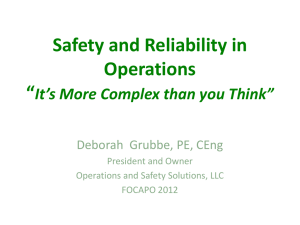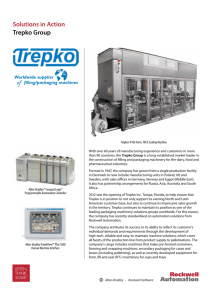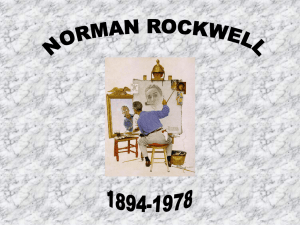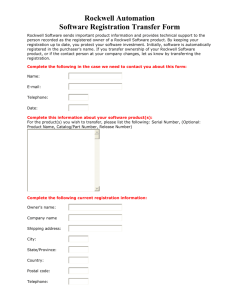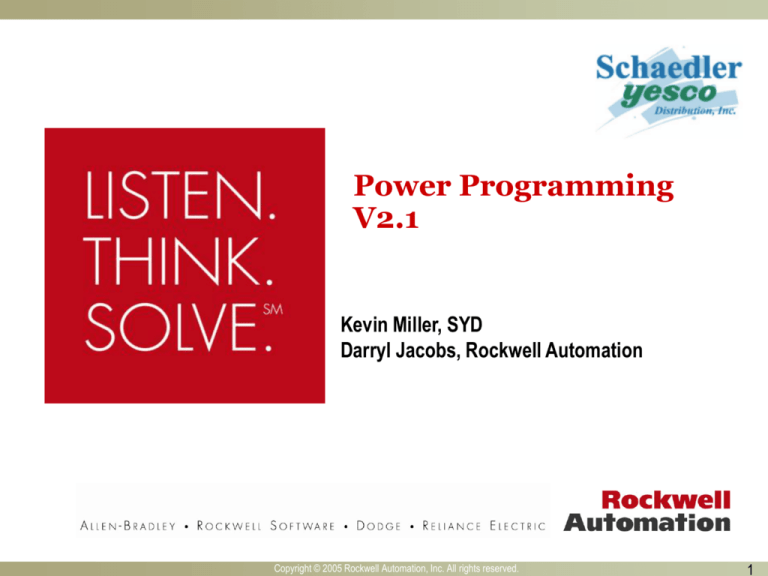
Power Programming
V2.1
Kevin Miller, SYD
Darryl Jacobs, Rockwell Automation
Copyright © 2005 Rockwell Automation, Inc. All rights reserved.
1
What is Power Programming?
• Clear and consistent structure
Axis Enabled Condition
Axis Enabled Command
– Easy to follow program example.
– Application note to guide you through a program example.
• State Model programming
– Pack ML State Model as “Behavioral Model for machine”
• Standardized Tags
– Pack Tags are used to provide raw efficiency data.
Copyright © 2005 Rockwell Automation, Inc. All rights reserved.
2
What can Power Programming do for you?
•
•
•
•
Save time
Save money
Allow you to reuse modules in future projects
Make troubleshooting easier in all machines in which you use
modular code -- no matter the customer or application
• Provide a quicker return on investment
Copyright © 2005 Rockwell Automation, Inc. All rights reserved.
3
So many standards, so little time!
ERP
Level 4
Business Planning & Logistics
Plant Production Scheduling,
Operational Management, etc
Level 3
MES
Manufacturing
Operations & Control
Dispatching Production, Detailed Production
Scheduling, Reliability Assurance, ...
Levels
2,1,0
Batch
Control
Continuous
Control
Discrete
Control
Motion
Control
Equipment Control
Automation
Adapted from: ISA-95.00.01-2000
ISA 95
ISA 88
IEC 61512
OPC
PackML*
IEC 61131
Fieldbus
Intelligent Devices
* PackML Model is in development
4
Copyright © 2005 Rockwell Automation, Inc. All rights reserved.
Rockwell Automation has assembled the right tools
for the job
• The application engineer’s toolbox:
– Functional specifications
– Program structure examples
– State models
– Machine control templates
– Axis routine module templates
We call it:
Power Programming
Copyright © 2005 Rockwell Automation, Inc. All rights reserved.
5
Power Programming is:
• Integrated
– Provides interoperability with plant-wide systems through Logix
– Provides standard animated diagram showing the various machine states arranged in a
flow diagram
From shop floor to top floor, you and
your applications down the line, will
know exactly what is going on with each
of your applications, no matter where
you are in the plant or which application
you’re looking at -- only one play book
required
Copyright © 2005 Rockwell Automation, Inc. All rights reserved.
6
RA Power Programming
Notice the consistent structure, between
the Machine program and the Line
Program. The Machine Logic is the
routine that the Hardware I/O is
connected to, E-Stops and permissive.
This structure was reused for line
connections to individual machines.
Machine Logic
State Logic
The Same State Logic was used,
there are NO differences between
these routine (Except one is written
in ladder and the other is a SFC for
illustration of different programming
techniques.
Copyright © 2005 Rockwell Automation, Inc. All rights reserved.
7
RA Power Programming
Copyright © 2005 Rockwell Automation, Inc. All rights reserved.
8
How PhaseManager fits into ISA-88 (S88)
batch control model
All the instructions to make a product.
(For example, Tomato Soup Recipe)
Recipe
SFC(s) defining
the order in
which the phases
run. Can be
collapsed to just
a Procedure.
Defines product-specific
Formula Values recipe values. (Use 200
Procedure
gallons water)
Consists of
Unit Procedures
Consist of
Operations
RSBizWare Batch provides Batch
Management for this part for complex
batches OR an SFC routine in the
controller can be the entire Procedure
for a simple batch.
Consist of
Lowest level of
recipe control.
(Add Water)
Phases
Support ISA-88
Phase State Model.
PhaseManager in the controller
provides the state logic framework for
phases and enforces the state model.
Copyright © 2005 Rockwell Automation, Inc. All rights reserved.
9
Controller Organizer View
• Phases are created and scheduled at the task level (similar to Programs)
• Phase state routines are created within a phase
– Can be written in any language
Equipment Phases
added in Task View
Phase Scoped Tags Folder
and Control Tags are
automatically generated.
Not all States need to be
implemented – only those
implemented are shown
Phases can be
unscheduled
Copyright © 2005 Rockwell Automation, Inc. All rights reserved.
10
Programs compared to Phases
Program
Phase
Batch Sequencer
Application Code RSBizWare Batch
•
•
•
•
1 Main Routine per program
Main is called each time task executes
Main calls other subroutines based on user
Logic
Monitor code within routine to determine
what is executing
•
“- ing” routines act like main routines
–
•
•
Aborting, Holding, Resetting, Restarting, Running, and
Stopping
Execution determined by phase sequencer
(RSBizWare Batch or application code)
Phase monitor tool to see which routine is
executing
Copyright © 2005 Rockwell Automation, Inc. All rights reserved.
11
Equipment Phase Backing Tag
• A controller-scoped
equipment phase
backing tag is created
by RSLogix 5000
automatically
• Tag’s name matches
equipment phase name
Equipment Phase
Backing tag
– Makes code easier to read
• Allows users to debug
and monitor equipment
phase’s execution
• Tag is accessible via HMI
screens
• Additionally, it provides
self-documenting code by
leveraging the description
pass-through functionality
Copyright © 2005 Rockwell Automation, Inc. All rights reserved.
12
Create Phase State Routine
• Phase State routines are just like “Normal” routines except:
– Have a fixed name
– Are executed according to the state machine rules
Select
equipment
phase state
• State names chosen from a list of
valid states:
–
–
–
–
–
–
Restarting
Running
Holding
Resetting
Stopping
Aborting
Select equipment
phase state
language
• Just like “Normal” routines, state
routines can be implemented in
any available language
–
–
–
–
Ladder Diagram
Sequential Function Chart
Function Block Diagram
Structured Text
Copyright © 2005 Rockwell Automation, Inc. All rights reserved.
13
Physical Model
Process
Cell
Unit
Equipment
Module
Control
Module
Vertical Form Seal Machine
Copyright © 2005 Rockwell Automation, Inc. All rights reserved.
14
OEM benefits
• Design efficiencies
– Reusability
• Standardized, modular code development improves time to market
– Improves design quality
– Reduces errors
– Uses best practices
– Training costs can be focused
•
Scalability
– Uses the same straightforward terminology no
matter the size of your machine
• allows you to easily match what customer is already using because of standardized
code
• common interface minimizes customer resistance to a different brand of machine
(e.g., Siemens can be migrated to A-B easily)
• Simplified maintenance
– Standardized code allows allows for simplified troubleshooting
– Less training required if all of the machines behave the same way
Copyright © 2005 Rockwell Automation, Inc. All rights reserved.
15
The right tools for the job
• The application engineer’s toolbox:
–
–
–
–
State models
Functional specifications
Modular code use examples
Machine program structure examples
We call it:
Power Programming
Copyright © 2005 Rockwell Automation, Inc. All rights reserved.
16
Let’s take a lesson
• Observe what has taken place in batch with regard to defined
standards and powerful tools to model, create, and monitor
systems.
• Motion Control and Packaging is undergoing some of the same
development.
• Generally the end customer needs are well defined;
–
–
–
–
–
Access to efficiency information.
Maintainable code or a great support contract.
Highest performance possible from the machine.
Low cost of integration of machine into facility.
A clean intuitive HMI.
Copyright © 2005 Rockwell Automation, Inc. All rights reserved.
17
Times are Changing
The packaging world has gone from (Line
shaft) to (some servos) and
(Integrated servo motion) machines.
increased complexity of the control
system required to run these machines
compel technology providers to
provide a more structured approach to
integrating these control systems. In
the end we would like to have a
method available to integrate our
systems with consistent tags, and
data.
Copyright © 2005 Rockwell Automation, Inc. All rights reserved.
Cam
18
What RA is doing to help
•
Rockwell Automation is continually
pursuing and incorporating what
you need to be successful
– active on industry committees to
keep abreast of emerging
practices and technology
– incorporating new industry
technology and trends to provide
the right tools
Level
s
2,1,0
Batch
Control
Continuous
Control
Discrete
Control
Motion
Control
ISA 88
IEC
61512
OPC
*PackML
Equipment Control
Automation
IEC 61131
Fieldbus
Intelligent Devices
Adapted from: ISA-95.00.01-2000
* PackML Model is in development
– creating integrated, modular programming to provide:
•
•
•
•
A modular format
A consistent structure
State models
Consistent terminology
Copyright © 2005 Rockwell Automation, Inc. All rights reserved.
19
PackML
•
Covers
– Auto Mode State Model (S88
derived)
– Data Definitions (Pack Tags)
•
Assists
– Derive efficiency information through
Pack Tags
– Maintenance & Trouble Shooting
through common approach in
Machine Sequence
– Consistent data format makes
integration go smoother, adoption of
a OEM machine is easier.
Copyright © 2005 Rockwell Automation, Inc. All rights reserved.
20
How Power Programming Helps You
• Allows you to view HMI using a machine state model
Copyright © 2005 Rockwell Automation, Inc. All rights reserved.
21
OEM benefits
• Design efficiencies
– Reusability
• Modular code development improves time to market
– Improves design quality, and reduces errors
– Uses best practices
– Scalability
• allows you to easily match what customer is already using because of standardized code
• Uses the same straightforward terminology no matter the size of your machine
• Common interface minimizes customer resistance to a different brand of machine (e.g., Siemens can be
migrated to A-B easily)
– Simplified maintenance
• Standardized code allows allows for simplified troubleshooting
• Less training required
Copyright © 2005 Rockwell Automation, Inc. All rights reserved.
22
End user benefits
• Simplified maintenance
– Easier machine integration.
– Quicker upgrades and on-site changes
• Less downtime
– Standardization means easier troubleshooting
– Lower training costs
– Reduced changeover time
• Production
–
–
–
–
Greater machine interoperability
Higher efficiencies
Standardized efficiency reporting
Lower operator training costs
Copyright © 2005 Rockwell Automation, Inc. All rights reserved.
23
Rapid Application Development
When you reuse code multiple
times in one program:
C Programmers = Instances
Automation Desktop =
Subsystems
ISA S88 = Equipment Modules
Machine builders = Sections
Reusable code is sometimes
referred to as:
C Programmers = Classes
Automation Desktop = Templates
ISA S88 = Equipment Modules
Machine builders = Sections
Develop quickly Control Applications by reusing
libraries of standard Logix program objects that
contain all the data and code required to control every
device in the plant floor
Copyright © 2005 Rockwell Automation, Inc. All rights reserved.
24
Visio Version of state model
Auto State Model Diagram
From Producing
STOPPING
1) Stop Initiated on Master
2) Once Master Stops All axes
commanded to stop and
disable feedback.
State=32
Stop
Command
Stop
Process
Complet
e
Initialize
Comman
d
STOPPED
1) System powered.
2) All Axes Off (Feedback Off)
3) Axes must be homed and
repositioned before running.
State=1
STARTING
1) Axes faults are cleared
2) Axes are enabled, Homed
& moved to start positions
3) Gearing/Cams initialized
4) Master not Started
State=2
Stop
Command
Initialize
Process
Complet
e
READY
1) Starting Functions
Complete
2) Axes Geared/Cammed
3) Master NOT running
Stop
Command
Start
Comman
d
STANDBY
1) Machine armed for
produce conditions to
commence motion.
State=4
Fault
Fault
Stop
Command
Start
Command
HELD
1) Holding Command
Completed
2) Axes Remain active.
State=8
State=128
Fault
Hold
Command
Fault
Produce
Condition
s
Become
False
Produce
Condition
s
Met
To Stopping
Fault
Holding
Process
Complet
e
Stop
Command
Stop
Command
Auto Mode Initiated
BY Operator
(START AUTO)
ABORTED
PRODUCING
1) All Axes Off (Feedback Off)
2) Axes must be homed and
repositioned before running.
3) Fault indications remain
for review by operator
State=512
1) Master Started
2) All axes performing auto
motion
3) Bars being packaged
State=16
HOLDING
Hold
Comman
d
1) Coordinated stop initiated
on master.
2) All axes remain geared or
cammed
State=64
Fault
Fault
ABORTING
Aborting
Process
Complete
State Transitions
Initialize Command
Start Command
Stop Command
Hold Command
Initialize Process Complete
Start Process Complete
Stop Process Complete
Hold Process Complete
Produce Conditions
Fault
1) Axes Individually commanded
to stop (no coordination)
2) After Stopping Axes Disable
Feedback.
State=256
Draw ing Title: Auto State Diagram Rev1.0
Creation Date: January 15, 2003
File Name:
Copyright © 2005 Rockwell Automation, Inc. All rights reserved.
AutoStateModel.vsd
25
States and Transitions
For this state
Look for
Stopped
Machine powers up in stopped
state, or from pressing the
Stop Button
Starting
Transition
Example
How is this machine initalzed
1) System powered.
2) All Axes Off (Feedback Off)
3) Axes must be homed before running.
Example
--> Starting
Initilaize push button transition
--> Ready
--> Stopping
--> Aborting
Initialize completes successfully
Stop PB transition
Fault active
--> Standby
--> Stopping
--> Aborting
Start PB Transition
Stop PB transition
Fault active
State=1
1) Axes faults are cleared
2) Axes enabled, Homed & moved to start position.
3) Gearing/Cams initialized
4) Master not Started
State=2
Ready
Automatic transition when all
axes have completed starting
functions.
Standby
This means someone has
pressed the Start button.
Producing
Making Product.
Stopping
Cycle stopping and disabling
the machine.
Holding
Held
This is a Pause or Hold
command indicating it will cycle
stop and servos will remain
active.
Held with Servos Active
1) Starting Functions Complete
2) Axes Geared/Cammed
3) Master NOT running
State=4
1) Machine armed for produce conditions to commence motion.
State=8
-->
-->
-->
-->
Producing
Holding
Stopping
Aborting
State=16
-->
-->
-->
-->
Standby
Holding
Stopping
Aborting
1) Master Started
2) All axes performing auto motion
3) Bars being packaged
1) Stop Initiated on Master
2) Once Master Stops All axes commanded to stop and disable
feedback.
State=32
--> Stopped
--> Aborting
Stop PB transition
Fault active
1) Coordinated stop initiated on master.
2) All axes remain geared or cammed
--> Held
--> Aborting
Holding functions complete
Fault active
State=64
1) Holding Command Completed
2) Axes Remain active.
State=128
Aborting
A major fault has occurred,
stopping functions comencing.
Produce Conditions Met
Hold PB transition
Stop PB transition
Fault active
Produce Conditions go away
Hold PB transition
Stop PB transition
Fault active
1) Axes Individually commanded to stop (no coordination)
2) After Stopping Axes Disable Feedback.
--> Standby
--> Stopping
--> Aborting
Start PB Transition
Stop PB transition
Fault active
--> Aborted
Fault active
--> Stopped
Stop PB transition
State=256
Aborted
Machine is stopped axes
disabled.
Copyright © 2005 Rockwell Automation, Inc. All rights reserved.
26
Program Flow Diagram
This example illustrates Initialization operation of this program, because it is the first
sequence that is commanded from the stopped state..
Machine.AutoState = Stopped
Init PB pressed
R02
Machine
Conditions
R02_Machine_Conditions
In our example project, we use the Start pushbutton, twice.
If in the Stopped state when pressed, we consider it an st.initialize command.
If in the Ready state when pressed, we consider it a st.start command.
R04_Auto_State
First time through
Machine.AutoState = Starting
When st.init_pc
Machine.AutoState = Ready
R04
Auto State
When in Stopped state and st.initialize the commanded state will transition
into Starting state.
st.Init_pc
R06_Auto_State_Command
R07
Section
Conditions
R06
Auto State
Command
sequence
command
complete
EM1...n (machine sections)
OR
CM1...n
(axis, actuator etc)
CM1...n
(axis, actuator
etc)
When in Starting state there is a sequence of operations that take place;
SectionCommands.Enable when All_enable_Done (meaning all axes
within that section are emabled) the next sequence is initiated
SectionCommands.Home and so on until all required starting functions are
complete.
Then st.init_PC is returned (meaning State.Initialize Process Complete)
Note: st.xxx instructions are State
Transitions, and only used to drive the
states of the PackML State model in R04.
R07_Section_Conditions
This routine gets status from
each axis program, or Control
Module to validate that the
commanded state of each
request was reached. These
we call conditions, we have
issued the command and wait
for the conditions to be true
before continuing.
Copyright © 2005 Rockwell Automation, Inc. All rights reserved.
27
Pseudo Code to Program View
R02_Machine_Conditions
In our example project, we use the Start pushbutton, twice.
If in the Stopped state when pressed, we consider it an st.initialize command.
If in the Ready state when pressed, we consider it a st.start command.
R04_Auto_State
When in Starting state there is a sequence of operations that take place;
SectionCommands.Enable when All_enable_Done (meaning all axes
within that section are emabled) the next sequence is initiated
SectionCommands.Home and so on until all required starting functions are
complete.
Then st.init_PC is returned (meaning State.Initialize Process Complete)
Axis Enabled Condition
R06_Auto_State_Command
Axis Enabled Command
When in Stopped state and st.initialize the commanded state will transition
into Starting state.
Note: st.xxx instructions are State
Transitions, and only used to drive the
states of the PackML State model in R04.
Copyright © 2005 Rockwell Automation, Inc. All rights reserved.
28
How to integrate using base code
Copyright © 2005 Rockwell Automation, Inc. All rights reserved.
29
How to qualify its use
1.
Clear Structure
–
Local tags in main program
–
Sub routines
•
•
MachineConditions
AutoStateCommands, AutoState, SectionConditions
2.
State Model
3.
Built in data structure
•
UDT Pack Tags
How to know if someone is using Power Programming? If you have these three elements from
our program sample you are using it.
Copyright © 2005 Rockwell Automation, Inc. All rights reserved.
30
Steps
Stepping up in technology and structure.
Take a look at where we are today and where we are
heading…
State Models
introduced, use of
structure
Hand build
one of a
kind code.
Power Programming
-PML State Model
-Clear Structure
-Best Practices
-Pack Tags 2.0
Advanced Code
-Cam Builder
-Higher Performance
-Appnotes/Sample Code
Artistic code
-Generally fast executing
-Often difficult to follow
-always requires further integrations work
Copyright © 2005 Rockwell Automation, Inc. All rights reserved.
31
A walk through Initialization
R02_Machine_Conditions
Init PB pressed
R02
Machine
Conditions
R04_Auto_State
R04
Auto State
When in Stopped state and st.initialize the commanded state will
transition into Starting state.
R06_Auto_State_Command
R07
Section
Conditions
R06
Auto State
Command
sequence
command
complete
EM1...n (machine sections)
OR
CM1...n
(axis, actuator etc)
CM1...n
(axis, actuator
etc)
When in Starting state there is a sequence of operations that take place;
SectionCommands.Enable when All_enable_Done (meaning all axes
within that section are emabled) the next sequence is initiated
SectionCommands.Home and so on until all required starting functions
are complete.
Then st.init_PC is returned (meaning State.Initialize Process Complete)
Axis Enabled Condition
This routine gets status from
each axis program, or
Control Moule to validate
that the commanded state
of each request was
reached. These we call
conditions, we have issued
the command and wait for
the conditions to be true
before continuing.
Axis Enabled Command
R07_Section_Conditions
In our example project, we use the Start pushbutton, twice.
If in the Stopped state when pressed, we consider it an st.initialize command.
If in the Ready state when pressed, we consider it a st.start command.
Note: any st.xxx instructions are State
Transitions, and only used to drive the
states of the PackML State model in
R04.
Copyright © 2005 Rockwell Automation, Inc. All rights reserved.
32
From a customer
•
•
•
•
•
Q The PACKML automatic mode state model provides an excellent framework or structure for organizing and developing machine
control applications.
A Consider Power Programming with Pack ML a behavioral model for a machine, or discrete process, ie. Starting= Initialize= do
whatever you have to do to get ready.
Q I am curious to know if you are aware of any OEMs or users who have adopted the PACKML automatic mode state model in there
automation specifications.
A I am aware of many of our OEM's that we have had this discussion with, and sometimes it breaks down when we get to adoption,
I am working on specifying what "using Power Programming" means. I have pretty much boiled it down to 3 elements, PackML state
model, State Transitions routine, Pack Tags 2.0. Beyond those basics the "artistry" of the OEM come back into play. We provide the
basic structure, Model, Structure, consistent Data.
•
Q Also, in your opinion, do you feel or have you seen that the PACKML automatic mode state model & PowerProgramming have
lead to significant re-use of code?
A I can speak for many of the Rockwell Applications Engineers when I tell you we use it as our "starter code". From and OEM-centric
point of view, it would be wise to reuse good structure and proven code for their machines also. I have been evangelizing the benefits
of code reuse for some time now, and believe the message is coming across loud and clear.
•
•
Q Do you find that the PACKML automatic mode state model useful for rapid development of machine functional requirements?
A Sure, we have used is as the foundation of the behavior model. See the Visio file attached to the examples available at
ab.com/powerprogramming.
•
Q Please let us know what your experience or knowledge is with respect to adoption of the PACKML automatic mode state model in
company standards, practices or specifications.
A Many of our customers are attempting to specify Pack ML, and we are presenting a more integrated solution with Power
Programming as the 3 elements I discussed earlier, and some example code to get them going. This goes far beyond the PackML
state model, and goes more into program structure.
•
Copyright © 2005 Rockwell Automation, Inc. All rights reserved.
33
Resources
• Power Programming Website www.ab.com/powerprogramming
• PackML OMAC Website www.packml.org
Copyright © 2005 Rockwell Automation, Inc. All rights reserved.
34
Thanks for your attention
Copyright © 2005 Rockwell Automation, Inc. All rights reserved.
35

